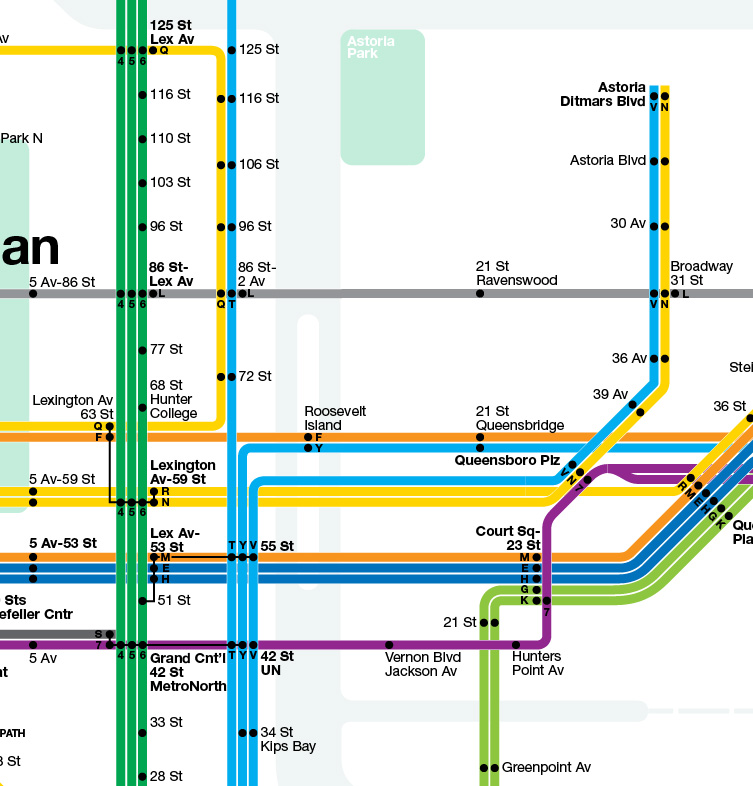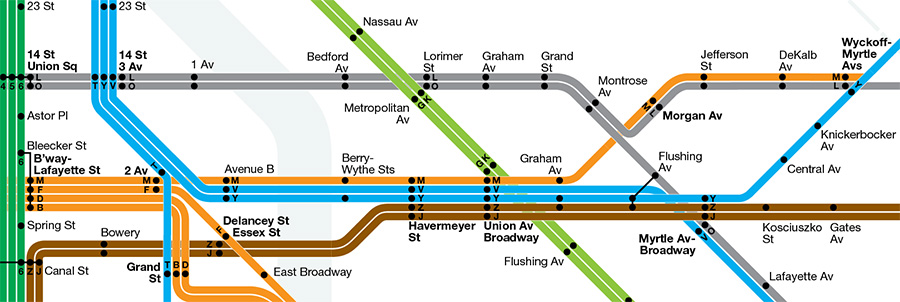
Subway Kitten-gate entered its second day today as the debate continued over whether or not the MTA should ahve shut power to the third rail to rescue some cats. The Post spoke to some people who were inconvenienced by the move, and they were, by and large, none too happy. Meanwhile, New York magazine polled the mayoral candidates on the issue and received better responses on the cats than on most other transit issues. Joe Lhota doesn’t advocated stopping the trains while Christine Quinn and Bill Thomspon, whose camp said he would “work to protect” the cats, seem to prioritize kittens over straphangers.
Anyway, enough of that. It’s Labor Day weekend, and some of this weekend’s service changes will last throughout Monday. Otherwise, subways and buses will operate on a Sunday schedule on Labor Day but with the J’Ouvert and West Indian-American Day Parades in Brooklyn, 4 trains will run local in the Borough of Kings.

From 11:45 p.m. Friday, August 30 to 5 a.m. Monday, September 2, downtown 1 trains run express from 72nd Street to Times Square-42nd Street due to cable work at Times Square-42nd Street for Flushing CBTC.

From 11:45 p.m. Friday, August 30 to 6:30 a.m. Saturday, August 31, from 11:45 p.m. Saturday, August 31 to 6:30 a.m. Sunday, September 1, and from 11:45 p.m. Sunday, September 1 to 5 a.m. Monday, September 2, downtown 2 trains run express from 72nd Street to Times Square-42nd Street due to cable work at Times Square-42nd Street for Flushing CBTC.

From 11:45 p.m. Friday, August 30 to 6:30 a.m. Saturday, August 31, from 11:45 p.m. Saturday, August 31 to 6:30 a.m. Sunday, September 1, and from 11:45 p.m. Sunday, September 1 to 5 a.m. Monday, September 2, 3 service is extended to 34th Street-Penn Station due to cable work at 42nd Street-Times Square for Flushing CBTC.

From 10 p.m. Sunday, September 1 to 7 p.m. Monday, September 2, service at the following stations may be affected by events related to the West Indian-American Day Parade:
- Eastern Parkway – 2, 3, 4
- Church Avenue – 2
- Utica Avenue – 3, 4
Please use nearby stations when directed.

From 11:45 p.m. Friday, August 30 to 6:30 a.m. Saturday, August 31, from 11:45 p.m. Saturday, August 31 to 6:30 a.m. Sunday, September 1, from 11:45 p.m. Sunday, September 1 to 6:30 a.m. Monday, September 2, and from 11:45 p.m. Monday, September 2 to 5 a.m. Tuesday, September 3, uptown A trains run express from Canal Street to 59th Street-Columbus Circle due to switch renewal north of 42nd Street-Port Authority and track tie renewal at Canal Street.

From 3:45 a.m. Saturday, August 31 to 10 p.m. Sunday, September 1, Lefferts Blvd-bound A trains skip 104th Street and 111th Avenue due to track panel work at Lefferts Boulevard.

From 6:30 a.m. to 11 p.m., Saturday, August 31, Sunday, September 1 and Monday, September 2, uptown C trains run express from Canal Street to 59th Street-Columbus Circle due to switch renewal north of 42nd Street-Port Authority and track tie renewal at Canal Street.

From 11:45 p.m. Friday, August 30 to 5 a.m. Tuesday, September 3, Jamaica Center-bound E trains are rerouted via the F line from 2nd Avenue to 21st Street-Queensbridge and downtown E trains are rerouted via the F line from West 4th Street to 2nd Avenue due to switch renewal north of 42nd Street-Port Authority and track tie renewal at Canal Street.
- No E trains between World Trade Center and West 4th Street. Customers should take the A or C instead.

From 11:30 p.m. Friday, August 30 to 5 a.m. Monday, September 2, there is no L train service between Lorimer Street and Broadway Junction due to track tie renewal at Lorimer Street and Graham Avenue. L trains operate in two sections:
- Between 8th Avenue and Lorimer Street
- Between Broadway Junction and Rockaway Parkway
- Free shuttle buses provide alternate service between Lorimer Street and Broadway Junction.

From 11:45 p.m. Friday, August 30 to 5 a.m. Tuesday, September 3, Coney Island-bound N trains are rerouted via the D from 36th Street to Stillwell Avenue due to track panel work south of 8th Avenue.
- D trains stop at New Utrecht Avenue-62nd Street
- For 45th, 53rd, and 59th Streets, customers should take the R instead.

From 11:45 p.m. Friday, August 30 to 5 a.m. Monday, September 2, Coney Island-bound N trains skip 30th Avenue, Broadway, 36th Avenue and 39th Avenue due to station painting at 30th Avenue.





 Within the cozy confines of New York politics, few positions are as potentially toxic as MTA CEO and Chairman. It is, essentially, that person’s duty to deliver bad news to New Yorkers who pay only casual attention to the inner workings of the agency’s politics and economics. Straphangers remember the service diversions and fare hikes; they recall the heat and the rats. They don’t remember the times the subways work as advertised, and they certainly don’t remember fondly those who oversee the comings and goings of the MTA.
Within the cozy confines of New York politics, few positions are as potentially toxic as MTA CEO and Chairman. It is, essentially, that person’s duty to deliver bad news to New Yorkers who pay only casual attention to the inner workings of the agency’s politics and economics. Straphangers remember the service diversions and fare hikes; they recall the heat and the rats. They don’t remember the times the subways work as advertised, and they certainly don’t remember fondly those who oversee the comings and goings of the MTA.